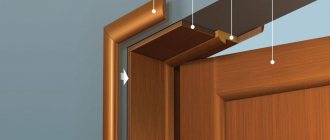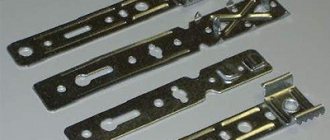Depending on the builders’ choice of technology and material for constructing walls, openings in buildings can have different configurations - there are windows with and without quarter windows. The existing differences do not have a fundamental impact on the main characteristics of the houses. However, the further choice of methods for measuring and installing window structures depends on them. To avoid mistakes when choosing windows, determining their correct dimensions and during installation, we recommend that you read the useful information from this article.
The importance of correct measurements
The manufacturer usually offers the services of its own measurer. This service is free. The product is manufactured on the basis of a measurement sheet, where the measurer indicates all the necessary parameters. If, when installing a window, difficulties arise due to an incorrectly manufactured product, the manufacturer will bear responsibility.
As a rule, window measurements are carried out by the manufacturer
If the customer provides the dimensions himself, then at the stage of signing the contract for the provision of services for the manufacture and installation of plastic windows, he signs the measurement sheet, which is drawn up by the manager based on the provided dimensions.
With his signature, the customer confirms the correctness of the dimensions indicated in the measurement sheet, in his words, which means that if the window does not fit during installation, the customer will bear responsibility and all financial costs for remaking the product will fall on his shoulders. When taking measurements yourself, it is important to approach this matter extremely responsibly.
Possible difficulties and errors
Let's list common mistakes:
- The use of non-special vapor-permeable film (external, external). Using polyethylene and the like instead is a gross mistake.
- Failure to comply with the rules for installing insulation (the tapes are glued carelessly, are not smoothed, and the ends are not overlapped).
- Non-foaming of the support profile inside, if one is used.
- Poor quality foaming. This procedure must be done slowly, carefully, so that there are no voids or cavities.
- PSUL tape is applied long before installing the window and pressing it to the quarter. This material expands over time, so it must be fixed immediately before inserting the glass unit into the opening.
- Incorrect depth selection and fastener spacing.
- Checking the level of evenness of the position of the window block is ignored. This must be done often several times at each stage of work.
Attention! If wedges are used, then a good solution would be to take even ones so that they can be placed not across, but along the opening - this way the foam seam will be unbreakable, as required by GOST.
The bottom of the opening is insulated especially carefully:
General rules
Measurements of window openings are performed from two sides: from the inside and from the outside of the room. In this way, the first important value is determined - the depth of the window opening. .
In panel houses, a typical situation is when the window openings were initially made with significant distortions at the stage of installation of slabs during the construction of the house. These values should be taken into account when installing plastic windows, and based on them, increase the size of the manufactured window. Internal and external measurements should be compared and the error determined.
When taking measurements, it is necessary to take into account possible distortions
After installing the window, to visually correct the curvature, you can use slopes, which not only give the window opening a neat appearance, but also prevent condensation from accumulating due to high humidity, thereby preventing the formation of mold.
To identify possible miscalculations, it is useful to compare the internal dimensions of the opening with the expected dimensions of the new window. The error in measurements should not exceed ten millimeters.
Where is it used?
This building material remains traditional. When constructing all kinds of buildings, a certain type of brick is used. In order to save building materials, it is not advisable to use solid bricks for continuous masonry. It is better to make a solid wall from light and hollow material. Quarter brick masonry is used for the construction of internal partitions of a room. With modern capabilities for the production of building materials, bassoon and facing bricks are produced that are equal in size to quarters of ordinary building materials and are used for external finishing work of buildings and decoration, cladding the foundation.
Quarter windows
When installing a plastic window in a brick house, there are some nuances. Window openings in brick houses are characterized by the presence of quarters, which are protruding brick fragments that prevent the possible loss of window frames. According to standards, a quarter should have a size of 6.5 cm, but in practice this size can be any.
The standard size of a quarter is 6.5 cm
Therefore, it is extremely important to take this feature into account so that during installation there are no problems with the installation of drainage. To do this, provide a distance of 1.5 - 2 cm from the upper border of the lower quarter to the window frame. The window frame should be installed no higher than 1.5 cm relative to the upper quarters, and 4-5 cm relative to the side quarters .
During installation there should be no contact between the frame and the existing window opening. The gap size at the bottom should be at least 4 cm, at the top and side - at least 5 cm. This is due to the fact that plastic windows are installed using polyurethane foam, which has the property of primary and secondary expansion.
When installing a window in a brick house, it is necessary to take into account the presence of quarters
To prevent the structure from “sinking” after a secondary increase in foam volume, spacers are installed around the perimeter of the window at the window installation stage.
If, when installing a window, it is planned to install an external drainage system and a window sill, then this entails the need to install a support profile to which these elements will be mounted. Therefore, the height of the window must be reduced by the height of the stand profile, which is 3 cm.
Briefly about the main thing
Knowing how to correctly measure the opening for a plastic window, you can do it yourself, saving time on having a technician go home. But for this you need to take into account many nuances: the type of opening, the material of the walls, the presence of finished slopes and window sills, the possibility of shrinkage of the house. And if the shape of the window block is non-standard, everything becomes even more complicated. Problems that arise as a result of incorrect measurements are compensated by the one who made them, so it is better to save not time, but your own money, entrusting this matter to professionals.
Windows without quarters
When deciding how to measure a window without quarters, you need to do a few simple steps. The width of the future window is calculated after measuring its upper and lower parts. In this case, for the calculation, a smaller value is taken, from which 4 cm is subtracted for the placement of installation seams on both sides - the result is the width of the future product.
It is worth considering that the greater the error when measuring the width in several places, the greater the number of centimeters that will need to be subtracted to determine the final size.
The size of the seams must be subtracted from the width of the window opening.
Calculating the height of a window product occurs according to the same rules as determining the width, only in this case, about 2.5 cm should be subtracted from the resulting value for the installation seam and 3 cm if a stand profile is installed.
Why do you need a stand profile?
A stand or substitution profile is an element that is placed at the bottom of the window product and has a height of 3 cm. An external drainage system made of powder-painted metal is attached to the stand profile. The ebb prevents the accumulation of precipitation and protects the installation seam from it.
A support profile is needed to secure the drainage system
On the inside of the room, a PVC window sill board is attached to the stand profile, which also hides the installation seam and makes the appearance of the window aesthetically pleasing.
A window sill is attached to the substitution profile from the inside
It is important to know that when installing a PVC window sill, its width will be 5 cm greater than a standard wooden one . At the customer's request, the window sill can be made up to 70 cm wide, but it must be taken into account that the heating radiator does not pass under it, since a wide window sill will prevent the proper circulation of warm air.
It is not recommended to install a window sill that is too wide above the battery
When calculating the width of the window sill, take into account its overhang, which cannot be less than 1 cm. The length of the window sill is equal to the width of the opening with access to the wall on both sides, which should not be less than 5 cm.
Installation algorithm in an already finished wall
The second option for arranging a window opening involves performing work on an existing wall. The workflow looks like this:
- First the marking is done. This stage involves identifying zones for placing jumpers and technological holes. The working stage is carried out using the triangle method, the lintel is marked so that its top is in the lower masonry row;
- Having made such marks, fifteen centimeters are added for each edge of the jumper. This distance is necessary to install supports that secure the lintel made of metal structures or reinforced concrete;
- installation of the support begins. It is necessary to provide a distance of seventy to eighty centimeters between the load-bearing wall and the supporting element;
- as soon as the support is placed, a wooden beam is laid on it, which is necessary to redistribute the load effects;
- a mark is made along the outer surface of the wall corresponding to the placement of the beams;
- in order to place these marks on the inside of the wall, drill holes into which studs are installed, supporting them on each side with supporting elements;
- the next stage is fixing the support. This can be done with ordinary nails, driving them into boards and studs;
- Using a hammer and a sharp chisel, the plaster layer is removed from the surface of the wall. The cleared area should correspond to the size of the future window opening. An additional three centimeters are added on each side;
- Having removed the plaster material, we begin dismantling the brickwork section. It is best to move from the place where the jumper is located, after that all that remains is to install it;
- all protruding bricks are adjusted;
- Having finished installing the jumper, use a grinder to make a cut. This will help to level the edges of the brickwork of the opening area, remove irregularities above the window, and facilitate subsequent processing of the slopes;
- At this stage, the design is completed, it is allowed to proceed with the installation of the window structure.
vote
Article rating
Features of measuring a balcony window
The structure on which the window will be installed in this case will be the balcony fencing, so the width of the window will be equal to its length. Since the combination of the side and front parts of the structure will be carried out by installing a corner profile in the required place, their width should be subtracted from the length of the fence - this will be the width of the new window.
Balcony measurement
The height of the product is the distance from the top of the fence to the balcony slab of the above floor. From this value you need to subtract 3 cm for making the installation seam.
Features of measuring window openings in private houses of old construction
Before measuring a window opening in an old private house, it is necessary to identify the actual dimensions of this opening. This requires dismantling the slopes. Often, significant gaps are hidden under the slopes, sealed with cement or insulation.
Before measuring a window opening in an old house, it is necessary to dismantle the slopes
During dismantling of the old frame, this entire additional structure may collapse and it turns out that the opening is much larger, which will only be a plus. But, if measurements were previously made using old windows, then all the free space will have to be restored instead of using wider windows.
When you need to strengthen
Most often used for windows of brick buildings:
If a new house is being built, then when drawing up the project, the most suitable method of strengthening door and window openings and arches is taken into account. But there are situations when it is necessary to strengthen the opening in an existing building.
The strengthening technology is selected depending on the thickness of the wall, what material it is made of, and the size of the hole itself. Several options are used to strengthen brick walls:
Arched brick purlin of window opening
To create a decorative element, the brick is made to protrude from the wall by 5-6 cm with the butt side. It is most convenient to make quarters on small steel channels. In addition to its decorative function, quarter masonry improves thermal insulation properties, which reduces the likelihood of drafts entering the house through the window.
Design Tips
When choosing a design, you should decide on its color, configuration, the presence of sashes and the desired opening mechanism, the presence of a window sill and ebb and flow.
As for the color range, the standard color of PVC windows is white; laminated profiles in walnut, mahogany, cherry, and oak are common. It is also possible to produce them in other colors, but due to their limited use, the cost of such windows is much higher. It is important to take into account that all windows on the facade of the building must be made in the same style and color, otherwise its architectural appearance will be disrupted.
The window configuration can be different: square, rectangular, round, triangular, polygonal, arched. Modern technologies for the production of plastic windows make it possible to realize any design ideas. In this case, the diameter of the arched structure should not be less than 50 cm.
The diameter of the arched window must be at least 50 cm
A plastic window can be blind or have sashes that are positioned vertically or in the form of a transom. When choosing the width of the sashes, it is important to consider that it may have a limit according to the catalog of window systems. Since perimeter fittings have limitations, the swing-and-turn sash cannot be made less than 40 cm wide .
The opening mechanism can be rotary, tilt or turn-tilt. When installing windows in panel houses, casing is not installed, but the slopes are finished and drainage is installed.
In panel houses, when installing plastic windows, drainage systems are installed and slopes are finished
In private homes, cashing is used to mask the installation seam and protect it from the effects of precipitation. If a low tide is installed, then cashing is mounted on three sides; if there is no low tide, then on four.
Video description
You can estimate how much dust and noise awaits you when expanding the opening by watching this video:
- gaps around the perimeter of the structure are too large, requiring sealing;
- insufficiently reliable fixation of the window unit in an opening that is too large, leading to the appearance of cracks;
- deformation of the window due to pressure resulting from shrinkage of the walls;
- deterioration in the performance of window fittings.
You cannot be immune from such problems even if all measurements are taken by window installers. But in this case, at least you won't have to pay to fix them.
Advice from professionals
If all the windows on the facade are to be replaced, then everything must be measured at once. Their height may be almost the same, but their width may differ. For manufacturing, you need to take the smallest value of the measured window.
To determine the location for installing the window unit, the thickness of the wall must be known. From the inside, the structure should be mounted to a depth equal to 2/3 of the width of the wall, while you can take into account the width of the external insulation and install it further.
If you add 5 cm to the width of the opening for the bend and 4 cm for the protrusion, then the required value of the drainage width will be known. If the wall is sheathed, then this thickness must also be taken into account. The width of the slopes is measured only after installing the window unit.
FAST
SEO optimization
Adaptive layout
Repair in the regions
- home
- Articles
- Wooden windows
- Window and door openings
1. Openings are made both in stone and in frame and chopped wooden walls, as well as on the side of the opening up to the bottom and in stone, plaster, wooden and other partitions
The openings are made wider than the window frames and door panels by the thickness of the frames. In addition, a gap must be left between the frame and the structure of the stone walls or partitions for subsequent sealing with thermal insulation or other material.
2. In frame buildings, the opening is formed by the appropriate installation of frame posts; in panel houses, an opening is left in the panels, while simultaneously with the manufacture of the panel, a box is installed and the frames or doors are hung.











